Attached are some photos of the current audio set-up in my upstairs converted small (161" L x 132" W x 103" H) bedroom. The center front of the main Stirling LS3/6 speakers is 34" from the wall behind them, and 22" from the walls beside them. The speakers stands are about 15 7/8" high. These stands put the woofer center about 27 3/8" above the floor. The bottom of the lower tweeter (which is the best sounding vertical axis for these speakers) is about 33" above the floor.
The listening position is at the 1/2 W, 2/3 L, and 1/3 H position, 34.25" above the floor. If I could get my ears down to 33" with this chair, I would. But, as you can see, this is as low as she goes; I already have removed the seat cushion. It is tough to find chairs which get my ears lower than 36" off the floor and this is the lowest "comfortable" chair I've found. I may eventually angle the front of the speaker stands up a bit to put my ears even more on the sweetest axis.
Four-inch-thick Sonex batts measuring 2' x 4' cover the areas where first-reflections of the speakers on the floor and wall surfaces can be seen from the listening position. The laminate floor is partially covered by a thick wool oriental rug and pad. There is one large-ish window to the right of the listening position, one large closet behind the listening seat (partially filled with audio paraphenalia, including serveral other sheets of the Sonex) and one entry door. The doors and windows are kept closed during measurements and serious listening, not because it sounds better that way, but for some modest amount of control of the amount of sound going outside and into the rest of the house.
This woofer positioning (where the product of the smallest and largest distance is about equal to the square of the middle distance) seems to address the Allison Effect fairly well. My measurements using the Omnimic system, show this woofer positioning, in combination with my chosen listening position, to have the smoothest overall bass response from the Stirlings while maintaining a wide-enough (about 62 degree) subtended angle between the two speakers.
In the views of the electronics, the AVA Humdinger is the small device on the floor on the left. Both Dayton Audio SA1000 subwoofer amps plug into it, and it is plugged into one of the two 20-amp dedicated lines for the audio in this room (each serviced by a quad of outlets). The Lyngdorf TDAI-2170 and subwoofer amps are powered by one dedicated circuit and the front-end components (Oppo BDP-105D, Squeezebox Touch, and Apple TV) are powered by the other dedicated circuit. The subwoofer amps sit directly on the floor on either side of the Ikea Lack table. The Lyngdorf sits under the Lack table on a Bright Star Audio Little Rock platform, separated from the floor by Bright Star Audio extra-large IsoNodes.
The Ikea table is leveled by layers of felt pads under its legs arranged so that the Oppo player is level as mounted. The Lack table's surface is damped by another different model of the Bright Star Audio Little Rock on its top surface. The Squeezebox Touch and Apple TV sit directly on the back corners of the Lack table. The Oppo is mounted in somewhat the same configuration as I employ in my downstairs system with the Harbeths. Going upward from the Little Rock:
I was previously just using Bright Star Audio extra large IsoNodes between the Oppo and the top of the Little Rock which damps the Lack table. That sounded quite fine, but headphone testing of this player versus the EVS-modified Oppo BDP-105 downstairs (using the headphone jacks of the two Oppo players) showed the downstairs player to sound somewhat cleaner, clearer, and more open. The only real difference between the two players was the mounting method. I therefore decided to spring for duplicating upstairs the player mounting method I was already using downstairs. Adding the Golden Sound cones, the Walker resonance control disks, the Mapleshade solid maple platform and Isoblocks--about $600 in total--to this upstairs system erased the differences I heard via headphones. Before I tested that, though, the improvement in bass cleanness, clarity further up, openness, and three-dimensionality, was unmistakably audible within a very few seconds through the LS3/6 speakers. This mounting method for the Oppo was recommended to me a few years back by Ric Schulz of Electronic Visionary Systems, the modifier of both my Oppo players. Scoff if you like.
For the time being, I am using the Oppo rather than the Lyngdorf as the source switcher. All sources are fed into the Oppo. The Squeezebox Touch (with Enhanced Digital Output software installed to allow a USB output) uses Oyaide USB cable to feed the Oppo's USB input. The Apple TV comes into the Oppo via its rear HDMI input via Blue Jeans FE HDMI cable. Tidal is streamed wirelessly via the Oppo's own USB Wi-Fi dongle plugged into a rear USB input of the Oppo.
I then use the input selector of the Oppo to feed the chosen source to the Lyngdorf via either Blue Jeans (Belden 1800 F) digital coax with Canare RCA plugs or Blue Jeans FE HDMI cable. I keep both digital connections because I haven't yet decided which one sounds better (if there is any difference at all--which blind testing tends to show is nonexistent) and since only the HDMI will feed SACD and other high-resolution digital signals to the Lyngdorf.
The Lyngdorf then controls the volume and applies digital processing such as RoomPerfect, the available EQ voicings (Neutral, Music 1, Music 2, Soft, etc.), and low and high pass crossover filters for the subs and mains. The Lyngdorf's low-pass filtered stereo analog line outputs then feed the analog LFE inputs of the two subwoofer amps so as to maintain stereo subwoofering. The two left channel subs are the one behind the left speaker and along the left wall. The two right channel subs are the one beside the right channel Stirling and the one by the bookcase.
Speaker cables to the main speakers are DNM with HFTNs and DNM bayonet banana plug terminations. The speaker cables for the subs are Blue Jeans 10 White with locking banana plugs. All connections are treated with Caig DeOxit Gold.
I still am not totally satisfied with RoomPerfect as implemented via my Lyngdorf TDAI-2170. While it does wonderful things in terms of evening out the bass range and solidifying the imaging/staging, it insists on brightening the upper ranges to sound more like a tin can (i.e., more like most other speakers) than the Stirlings do au natural. I'll keep working on the RoomPerfect set up, but I may have to ask Lyngdorf to produce a custom RoomPerfect EQ for me.
I need to add more soft things to this room, I know. But even as it stands, and even without RoomPerfect, this LS3/6 + Swarm system has strong legs. It has powerful bass, sounds very full bodied and smooth, while at the same time sounding clear and clean. Kind of like a concert-hall experience.
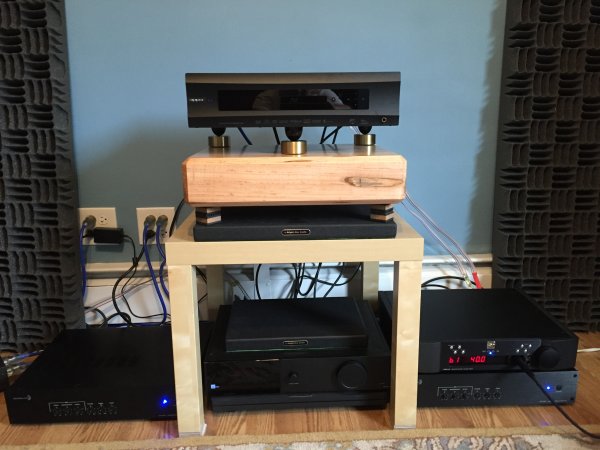
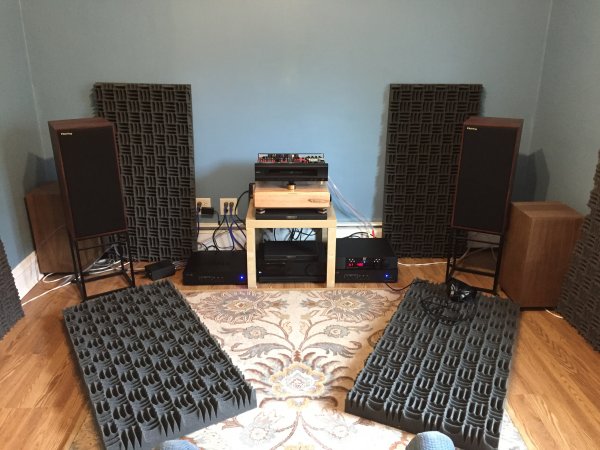
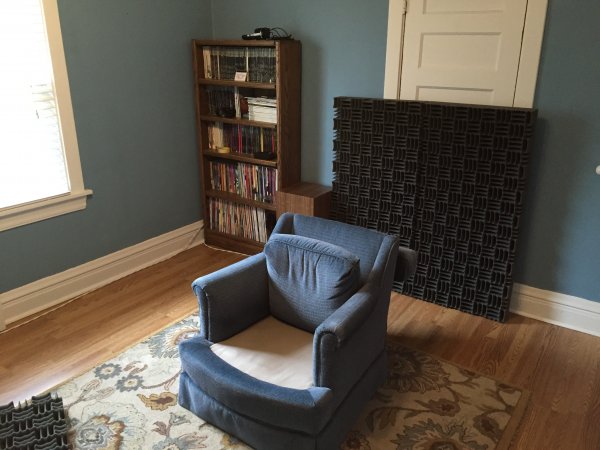
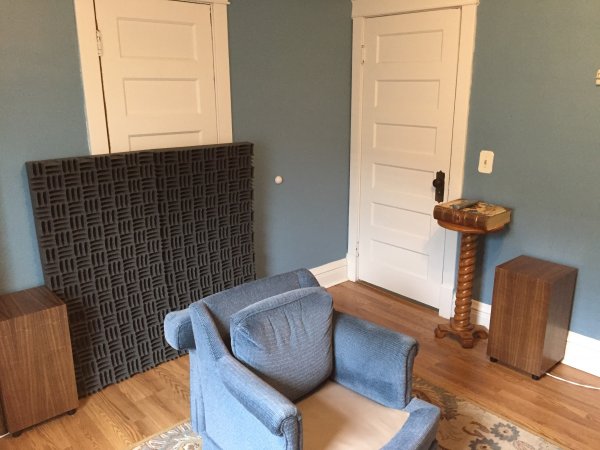
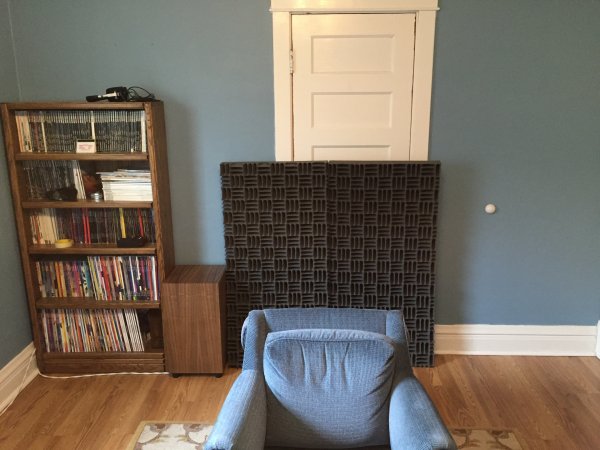
The listening position is at the 1/2 W, 2/3 L, and 1/3 H position, 34.25" above the floor. If I could get my ears down to 33" with this chair, I would. But, as you can see, this is as low as she goes; I already have removed the seat cushion. It is tough to find chairs which get my ears lower than 36" off the floor and this is the lowest "comfortable" chair I've found. I may eventually angle the front of the speaker stands up a bit to put my ears even more on the sweetest axis.
Four-inch-thick Sonex batts measuring 2' x 4' cover the areas where first-reflections of the speakers on the floor and wall surfaces can be seen from the listening position. The laminate floor is partially covered by a thick wool oriental rug and pad. There is one large-ish window to the right of the listening position, one large closet behind the listening seat (partially filled with audio paraphenalia, including serveral other sheets of the Sonex) and one entry door. The doors and windows are kept closed during measurements and serious listening, not because it sounds better that way, but for some modest amount of control of the amount of sound going outside and into the rest of the house.
This woofer positioning (where the product of the smallest and largest distance is about equal to the square of the middle distance) seems to address the Allison Effect fairly well. My measurements using the Omnimic system, show this woofer positioning, in combination with my chosen listening position, to have the smoothest overall bass response from the Stirlings while maintaining a wide-enough (about 62 degree) subtended angle between the two speakers.
In the views of the electronics, the AVA Humdinger is the small device on the floor on the left. Both Dayton Audio SA1000 subwoofer amps plug into it, and it is plugged into one of the two 20-amp dedicated lines for the audio in this room (each serviced by a quad of outlets). The Lyngdorf TDAI-2170 and subwoofer amps are powered by one dedicated circuit and the front-end components (Oppo BDP-105D, Squeezebox Touch, and Apple TV) are powered by the other dedicated circuit. The subwoofer amps sit directly on the floor on either side of the Ikea Lack table. The Lyngdorf sits under the Lack table on a Bright Star Audio Little Rock platform, separated from the floor by Bright Star Audio extra-large IsoNodes.
The Ikea table is leveled by layers of felt pads under its legs arranged so that the Oppo player is level as mounted. The Lack table's surface is damped by another different model of the Bright Star Audio Little Rock on its top surface. The Squeezebox Touch and Apple TV sit directly on the back corners of the Lack table. The Oppo is mounted in somewhat the same configuration as I employ in my downstairs system with the Harbeths. Going upward from the Little Rock:
- Three Mapleshade Audio Isoblock 1 rubber feet are arranged near the two front bottom corners and rear center of the . . .
- 4"-thick Mapleshade Audio solid maple platform with a clear lacquer finish.
- Three Walker Audio 1"-thick resonance control disks sitting atop the maple platform, arranged so that . . .
- Three Golden Sound DH Cones, the Jumbo size, which is the second largest version of the DH cones, used points down, contact the resin of the Walker disks, with the cones arranged at the back two corners of the player and at the front center of the player. The thin felt pads which come attached to the flat sides of the DH cones are left in place so that the felt contacts the bottom metal side of the player. The player's four stock feet--which are located at the four corners--are all removed. The mounting of the foot in the center front is in a valley in the bottom silvery metal piece about an inch back from the front.
- The player is operated with the cover removed.
I was previously just using Bright Star Audio extra large IsoNodes between the Oppo and the top of the Little Rock which damps the Lack table. That sounded quite fine, but headphone testing of this player versus the EVS-modified Oppo BDP-105 downstairs (using the headphone jacks of the two Oppo players) showed the downstairs player to sound somewhat cleaner, clearer, and more open. The only real difference between the two players was the mounting method. I therefore decided to spring for duplicating upstairs the player mounting method I was already using downstairs. Adding the Golden Sound cones, the Walker resonance control disks, the Mapleshade solid maple platform and Isoblocks--about $600 in total--to this upstairs system erased the differences I heard via headphones. Before I tested that, though, the improvement in bass cleanness, clarity further up, openness, and three-dimensionality, was unmistakably audible within a very few seconds through the LS3/6 speakers. This mounting method for the Oppo was recommended to me a few years back by Ric Schulz of Electronic Visionary Systems, the modifier of both my Oppo players. Scoff if you like.
For the time being, I am using the Oppo rather than the Lyngdorf as the source switcher. All sources are fed into the Oppo. The Squeezebox Touch (with Enhanced Digital Output software installed to allow a USB output) uses Oyaide USB cable to feed the Oppo's USB input. The Apple TV comes into the Oppo via its rear HDMI input via Blue Jeans FE HDMI cable. Tidal is streamed wirelessly via the Oppo's own USB Wi-Fi dongle plugged into a rear USB input of the Oppo.
I then use the input selector of the Oppo to feed the chosen source to the Lyngdorf via either Blue Jeans (Belden 1800 F) digital coax with Canare RCA plugs or Blue Jeans FE HDMI cable. I keep both digital connections because I haven't yet decided which one sounds better (if there is any difference at all--which blind testing tends to show is nonexistent) and since only the HDMI will feed SACD and other high-resolution digital signals to the Lyngdorf.
The Lyngdorf then controls the volume and applies digital processing such as RoomPerfect, the available EQ voicings (Neutral, Music 1, Music 2, Soft, etc.), and low and high pass crossover filters for the subs and mains. The Lyngdorf's low-pass filtered stereo analog line outputs then feed the analog LFE inputs of the two subwoofer amps so as to maintain stereo subwoofering. The two left channel subs are the one behind the left speaker and along the left wall. The two right channel subs are the one beside the right channel Stirling and the one by the bookcase.
Speaker cables to the main speakers are DNM with HFTNs and DNM bayonet banana plug terminations. The speaker cables for the subs are Blue Jeans 10 White with locking banana plugs. All connections are treated with Caig DeOxit Gold.
I still am not totally satisfied with RoomPerfect as implemented via my Lyngdorf TDAI-2170. While it does wonderful things in terms of evening out the bass range and solidifying the imaging/staging, it insists on brightening the upper ranges to sound more like a tin can (i.e., more like most other speakers) than the Stirlings do au natural. I'll keep working on the RoomPerfect set up, but I may have to ask Lyngdorf to produce a custom RoomPerfect EQ for me.
I need to add more soft things to this room, I know. But even as it stands, and even without RoomPerfect, this LS3/6 + Swarm system has strong legs. It has powerful bass, sounds very full bodied and smooth, while at the same time sounding clear and clean. Kind of like a concert-hall experience.





Last edited:

